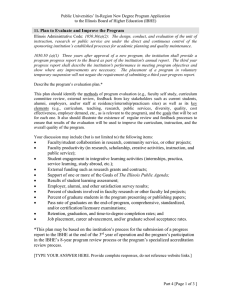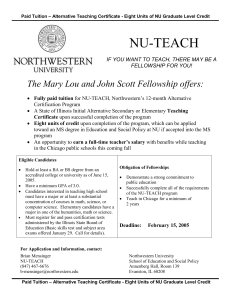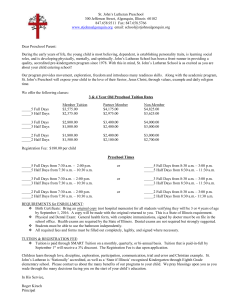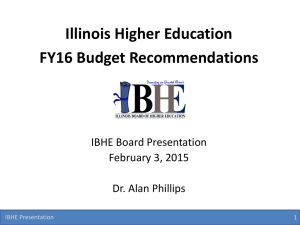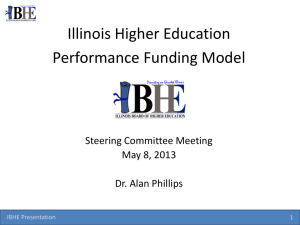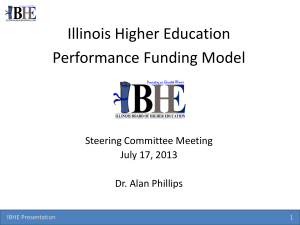doc - AAUP - Illinois Conference
advertisement
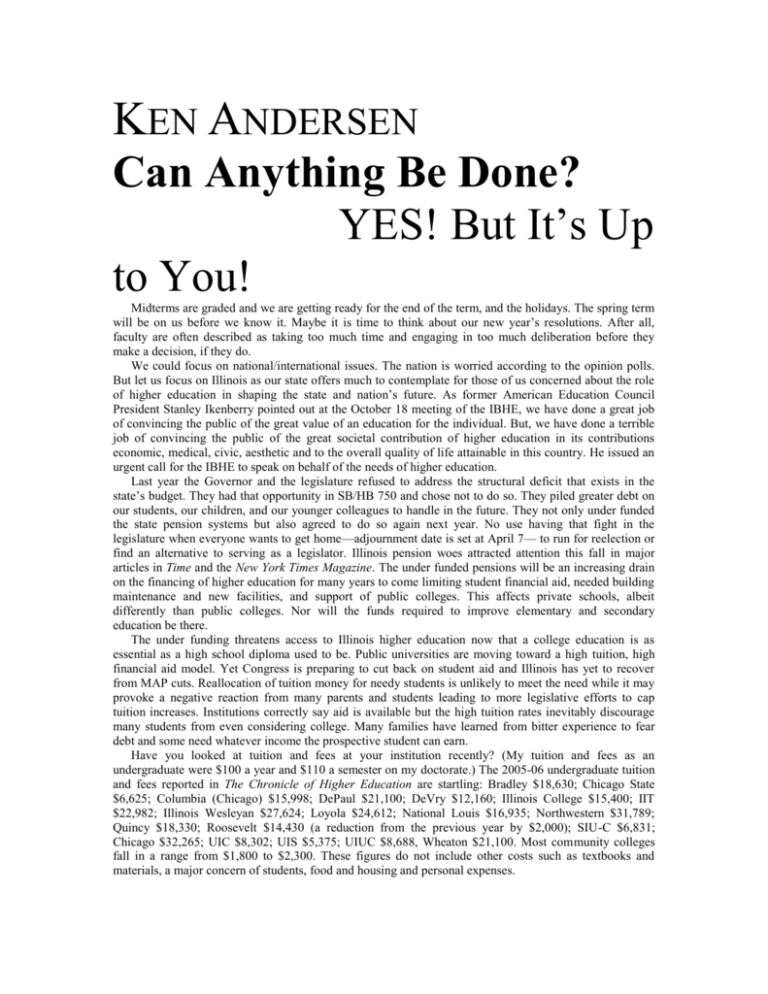
KEN ANDERSEN Can Anything Be Done? YES! But It’s Up to You! Midterms are graded and we are getting ready for the end of the term, and the holidays. The spring term will be on us before we know it. Maybe it is time to think about our new year’s resolutions. After all, faculty are often described as taking too much time and engaging in too much deliberation before they make a decision, if they do. We could focus on national/international issues. The nation is worried according to the opinion polls. But let us focus on Illinois as our state offers much to contemplate for those of us concerned about the role of higher education in shaping the state and nation’s future. As former American Education Council President Stanley Ikenberry pointed out at the October 18 meeting of the IBHE, we have done a great job of convincing the public of the great value of an education for the individual. But, we have done a terrible job of convincing the public of the great societal contribution of higher education in its contributions economic, medical, civic, aesthetic and to the overall quality of life attainable in this country. He issued an urgent call for the IBHE to speak on behalf of the needs of higher education. Last year the Governor and the legislature refused to address the structural deficit that exists in the state’s budget. They had that opportunity in SB/HB 750 and chose not to do so. They piled greater debt on our students, our children, and our younger colleagues to handle in the future. They not only under funded the state pension systems but also agreed to do so again next year. No use having that fight in the legislature when everyone wants to get home—adjournment date is set at April 7— to run for reelection or find an alternative to serving as a legislator. Illinois pension woes attracted attention this fall in major articles in Time and the New York Times Magazine. The under funded pensions will be an increasing drain on the financing of higher education for many years to come limiting student financial aid, needed building maintenance and new facilities, and support of public colleges. This affects private schools, albeit differently than public colleges. Nor will the funds required to improve elementary and secondary education be there. The under funding threatens access to Illinois higher education now that a college education is as essential as a high school diploma used to be. Public universities are moving toward a high tuition, high financial aid model. Yet Congress is preparing to cut back on student aid and Illinois has yet to recover from MAP cuts. Reallocation of tuition money for needy students is unlikely to meet the need while it may provoke a negative reaction from many parents and students leading to more legislative efforts to cap tuition increases. Institutions correctly say aid is available but the high tuition rates inevitably discourage many students from even considering college. Many families have learned from bitter experience to fear debt and some need whatever income the prospective student can earn. Have you looked at tuition and fees at your institution recently? (My tuition and fees as an undergraduate were $100 a year and $110 a semester on my doctorate.) The 2005-06 undergraduate tuition and fees reported in The Chronicle of Higher Education are startling: Bradley $18,630; Chicago State $6,625; Columbia (Chicago) $15,998; DePaul $21,100; DeVry $12,160; Illinois College $15,400; IIT $22,982; Illinois Wesleyan $27,624; Loyola $24,612; National Louis $16,935; Northwestern $31,789; Quincy $18,330; Roosevelt $14,430 (a reduction from the previous year by $2,000); SIU-C $6,831; Chicago $32,265; UIC $8,302; UIS $5,375; UIUC $8,688, Wheaton $21,100. Most community colleges fall in a range from $1,800 to $2,300. These figures do not include other costs such as textbooks and materials, a major concern of students, food and housing and personal expenses. While tuition and fees at public institutions are still sharply lower than at private schools, particularly the more prestigious ones, they have risen sharply in recent years and the public four-year institutions are being pressured/forced to adopt a high tuition-high aid model by the decline in state support. With the emphasis on higher education as a private good, many believe public institutions should set tuition at whatever level the market will bear. This will effectively close the doors to many students and fracture the American dream. It is not that faculty are overpaid. IBHE reports that median faculty salaries at the four-year publics are at 93.5% of peer institutions and our benefits packages lag as well. Community college salaries fare better in salary comparisons but there is a running dispute about the comparison base. Independent college and universities exceed those of their peer groups on the average but actual salaries vary dramatically from institution to institution. (For much greater detail, see the AAUP Academe data of last spring or the IBHE report of its October 18 meeting available online.) What can we do? One of the governor’s aides told me last year, “No one fears an angry faculty,” and “No one will support a tax increase to pay for pensions.” But the reality is the tax increase is needed to support education among other state needs. And yes, we need to resolve the problems caused by past and continued disastrous decisions to under fund the pension systems. That burden grows every year. One estimate is the shortfall is equal to two years of the state budget. What can an individual do? Maybe the recent national accolades for Rosa Parks tell us something. First, individuals can make a difference. Perhaps even more important, they remind us of the importance of narratives, of telling a story that captures attention and motivates change. The current emphasis on getting control of the “story” and “framing” by both the administration and the opposition suggests the importance of controlling the narrative. What does all of this suggest about our New Year’s resolutions? · We will tell the story of the impact on our students, our institutions, and ultimately the citizens of Illinois of the cuts imposed on higher education. Every institution, private or public, has been negatively impacted. Unless the pattern of declining state support for higher education is reversed, the state faces a significantly darker future. We are destroying the seed corn needed for tomorrow’s growth. We need to tell the story to friends, neighbors, legislators. It is not for our personal benefit that they need to support higher education, it is for the public good as well as their personal advantage for the long term. Surely we know something about the value of investing for the future and the value of compounding. · We will recognize and respond to the realities of the political climate. Little will be done during the spring legislative session to deal with the substantial financial issues that Illinois faces. But, substantial risks and opportunities will come with the fall 2006 veto session after the election. Now is the time for us to establish contact with legislators if we are to have any impact during that veto session. It is too late then. Yes, most legislators will be reelected given the ability to carve out safe political districts for incumbents. But don’t overlook those not reelected for they have greater freedom to vote their conscience. Don‘t overlook the power of the lame duck. · We will be active in shared governance on our campus and across the state. Fewer and fewer faculty are active in the shared governance process. We need to reinvent some elements of the process to ensure faculty have a meaningful voice and have ownership of change. If not actively engaged in shared governance activity we should be monitoring their activity and expressing appreciation to those who are actively engaged. Meaningful faculty participation in institutional governance is at greater risk now than it has been since tenure became a reality for most faculty. The role and responsibilities of the faculty are being redefined—too often without faculty participation in that process. Two years ago the National Communication Association gave me the honor of addressing our national convention on the topic “Recovering the Civic Culture.” I argued that we have been seeing a welldocumented loss of participation in the civic communal activities nationally and locally in voting, in civic groups such as the Rotary and the PTA, and in our own universities, colleges, and departments. In part, the decline in shared governance is because we have stopped participating in governance activity. We have voted with our feet and our allocation of time and commitment. I conclude as I did then with a citation by Molly Ivins. Although focused on politics, her words apply to every domain where we have need of a vibrant civic culture—our institutions are certainly one such place. “In this country, we have the most extraordinary luck—we are the heirs to the greatest political legacy any people have every received. Our government is not them, our government is us.. . . It’s our government, we can make it do what we want it to when we put in the energy it takes to work with other people, organize, campaign, and vote—we can still make the whole clumsy money-driven system work for us. And it’s high time we did so.”(Molly Ivins, “Offering up a host of examples identifying Bush’s many problems,” Chicago Tribune, September 18, 2003.) Ken Andersen is Professor Emeritus of Speech Communication, University of Illinois at Urbana-Champaign.
